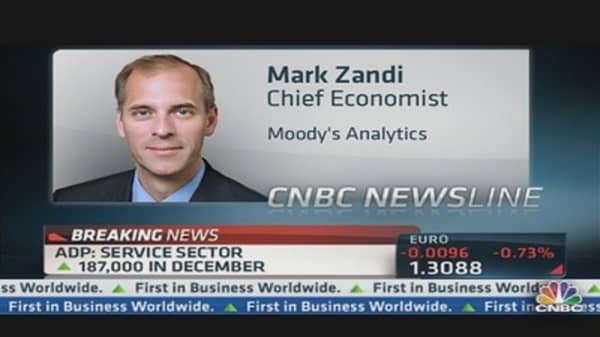Hatzius increased his estimate after ADP showed surprisingly strong private sector job growth of 215,000, ISM manufacturing data showed stronger hiring and help-wanted advertising picked up. (Read More: Private Sector Jobs Surge, Weekly Claims Rise)
The consensus forecast of economists for Friday's employment report is 150,000, according to Reuters, and 160,000, according to Dow Jones.
"I think it is looking a little better, but I still think Q1 GDP growth is not going to be that great, and we are getting the payroll tax cut expiration, and that's going to be a negative for consumer spending," said Hatzius. "There are other things that are looking a little positive. Maybe there's a little bit of a Sandy bounce back. If you look at the state-by-state numbers, New York and New Jersey were looking quite weak."
Hatzius said there could also be weather impact and seasonal distortion. "I think the signals are a bit better, but I would not make a huge deal about it."
J.P. Morgan has been expecting to see 195,000 jobs in December, including gains from Sandy.
"It should be pretty broad," said J.P. Morgan chief U.S. economist Michael Feroli of the employment gains. Feroli said the jobs added should be in a variety of sectors because of the general overall business disruption caused by Sandy.
But Feroli too says the December report could be followed by weakness.
"I think there's going to be some drag here from the fiscal cliff issues. That will probably hold things back awhile," he said.
Feroli said the first quarter impact from the reversal of the payroll tax holiday, which means a two percent tax increase for all taxpayers, could amount to more than 1 percent hit to GDP growth, and it could amount to 0.6 percent for the year.
Deutsche Bank chief U.S. economist Joseph LaVorgna raised his nonfarm payroll estimate to 190,000 from 150,000 Thursday, based on the ADP and some other recent readings. He pointed out that ADP showed that 86,000 jobs were lost due to Sandy last month so he too sees some of December's gains as weather-related.
Mesirow Financial chief economist Diane Swonk said she expects to see 160,000 total nonfarm payrolls, and private sector hiring would be 165,000 to 168,000 if public sector layoffs are not counted. Swonk said public sector numbers are being affected by the retirements of aging baby boomers.
"We've got some retirees kicking in, which is what's holding the public sector down, more than cuts. We're seeing in a lot of cities, Chicago for one, where they can't replace the police as fast as they retire," she said.
Swonk also thinks that first quarter employment could be challenged.
"There's a lot of cross currents of uncertainty about the fiscal cliff. It didn't completely destroy Christmas, but it wasn't a terrific Christmas by any means," he said. "We could see some layoffs in January. I'm a little cautious in the beginning of the year because of these dual battles of spending cuts and debt ceiling."
Swonk said the ADP report surprisingly showed an increase in construction workers but not in manufacturing, the opposite of what the ISM suggested.
Bank of America Merrill Lynch economists raised their forecast to 130,000 from 90,000 nonfarm payrolls. In a note they acknowledged their lower than consensus forecast.
"We feel comfortable with this forecast for three reasons. First, we anticipate retail hiring to be soft given the rapid gains in retail jobs over the prior three months. This is consistent with the strong start to the holiday shopping season but sluggish end. Second, business and consumer confidence remained weak in December, likely related to the fiscal cliff. And finally, initial jobless claims, after accounting for seasonal factors, are hovering at pre-Sandy levels," they wrote.
The employment report is released at 8:30 a.m. ET. The ISM non-manufacturing survey and factory orders are released at 10 a.m.





